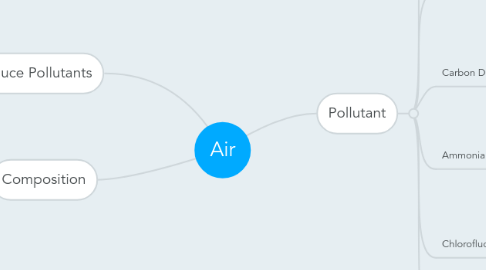
1. Ways to reduce Pollutants
1.1. Walk and use bicycle more often
1.2. Reduce, Reuse and Recycle
1.3. Educate people
2. Composition
2.1. By volume, dry air contains 78.09% nitrogen, 20.95% oxygen, 0.93% argon, 0.04% carbon dioxide, and small amounts of other gases. Air also contains a variable amount of water vapor, on average around 1% at sea level, and 0.4% over the entire atmosphere.
3. Pollutant
3.1. Carbon Monoxide
3.1.1. Carbon monoxide is a colorless, odorless, and tasteless gas that is slightly less dense than air. It is toxic to hemoglobic animals when encountered in concentrations above about 35 ppm.
3.2. Nitrogen Oxide
3.2.1. Nitrogen oxides are a group of gases that are composed of nitrogen and oxygen. Two of the most common nitrogen oxides are nitric oxide and nitrogen dioxide. The chemical formula for nitric oxide is NO; for nitrogen dioxide, it is NO2. Nitrous oxide, N2O, is a greenhouse gas that contributes to climate change.
3.3. Carbon Dioxide
3.3.1. Carbon dioxide is a colorless and odorless gas that is vital to life on Earth. This naturally occurring chemical compound is made up of a carbon atom covalently double bonded to two oxygen atoms.
3.4. Ammonia
3.4.1. Ammonia or azane is a compound of nitrogen and hydrogen with the formula NH₃. The simplest pnictogen hydride, ammonia is a colourless gas with a characteristic pungent smel
3.5. Chlorofluorocarbons
3.5.1. a class of compounds of carbon, hydrogen, chlorine, and fluorine, typically gases used in refrigerants and aerosol propellants. They are harmful to the ozone layer in the earth's atmosphere owing to the release of chlorine atoms upon exposure to ultraviolet radiation.
3.6. Volatile Organic Compound
3.6.1. Volatile organic compounds, sometimes referred to as VOCs, are organic compounds that easily become vapors or gases. Along with carbon, they contain elements such as hydrogen, oxygen, fluorine, chlorine, bromine, sulfur or nitrogen.
